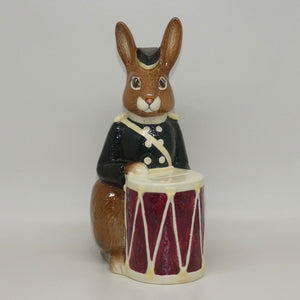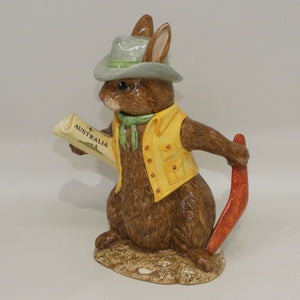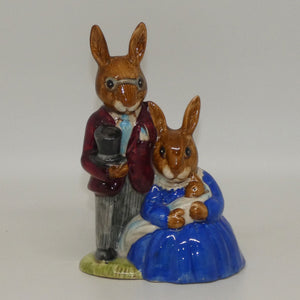{"id":8001903165668,"title":"DB438 Royal Doulton Bunnykins Inventors | James Brindley","handle":"db438-royal-doulton-bunnykins-inventors-james-brindley","description":"\u003cp\u003eRoyal Doulton Bunnykins Inventors series figure\u003cbr\u003e\u003cspan data-mce-fragment=\"1\"\u003eDB438 James Brindley\u003c\/span\u003e\u003cbr\u003e\u003cbr\u003eIssued in a Limited Edition of 1000 pieces\u003cbr\u003eMade in the Far East\u003cbr\u003eApprox 13cms (5 1\/4\") tall\u003cbr\u003e\u003cbr\u003eIn excellent condition \u003cbr\u003eWith box and Certificate \u003cbr\u003eGUARANTEED free from damage and repair\u003cbr\u003e\u003cbr\u003e\u003cb\u003eAbout James Brindley:\u003cbr\u003e\u003c\/b\u003eJames Brindley (1716 – 27 September 1772) was an English engineer. He was born in Tunstead, Derbyshire, and lived much of his life in Leek, Staffordshire, becoming one of the most notable engineers of the 18th century.\u003cbr\u003e\u003cbr\u003eBrindley's reputation brought him to the attention of the 3rd Duke of Bridgewater, who was looking for a way to improve the transport of coal from his coal mines at Worsley to Manchester.\u003cbr data-mce-fragment=\"1\"\u003e\u003cbr data-mce-fragment=\"1\"\u003eIn 1759 the Duke commissioned the construction of a canal to do just that. The resulting Bridgewater Canal, opened in 1761, is often regarded as the first British canal of the modern era (though the Sankey Canal has a good claim to that title), and was a major technical triumph. Brindley was commissioned as the consulting engineer. However, although Brindley has often been credited as the genius behind the construction of the canal, it is now thought that the main designers were the Duke himself, who had some engineering training, and his land agent and engineer John Gilbert. Brindley was engaged, at the insistence of Gilbert, to assist with particular problems such as the Barton Aqueduct. This most impressive feature of the canal carried the canal at an elevation of 12 metres (39 ft) over the River Irwell at Barton.\u003cbr data-mce-fragment=\"1\"\u003e\u003cbr data-mce-fragment=\"1\"\u003eBrindley's technique minimised the amount of earth moving by developing the principle of contouring. He preferred to use a circuitous route that avoided embankments, and tunnels rather than cuttings. Though this recognised the primitive methods of earth-moving available at the time, it meant that his canals were often much longer than a more adventurous approach would have produced.\u003cb\u003e\u003cbr\u003e\u003c\/b\u003e\u003c\/p\u003e","published_at":"2023-07-02T07:11:19+10:00","created_at":"2023-07-02T07:07:26+10:00","vendor":"Royal Doulton","type":"Bunnykins","tags":["Bunnykins","Type_Limited Edition"],"price":9000,"price_min":9000,"price_max":9000,"available":true,"price_varies":false,"compare_at_price":null,"compare_at_price_min":0,"compare_at_price_max":0,"compare_at_price_varies":false,"variants":[{"id":44013077004516,"title":"Default Title","option1":"Default Title","option2":null,"option3":null,"sku":"","requires_shipping":true,"taxable":true,"featured_image":null,"available":true,"name":"DB438 Royal Doulton Bunnykins Inventors | James Brindley","public_title":null,"options":["Default Title"],"price":9000,"weight":500,"compare_at_price":null,"inventory_management":"shopify","barcode":"","requires_selling_plan":false,"selling_plan_allocations":[]}],"images":["\/\/www.roundaboutantiques.com.au\/cdn\/shop\/files\/DB438_brindley_510_1a.jpg?v=1688245833","\/\/www.roundaboutantiques.com.au\/cdn\/shop\/files\/DB438_brindley_510_1b.jpg?v=1688245834","\/\/www.roundaboutantiques.com.au\/cdn\/shop\/files\/DB438_brindley_510_1c.jpg?v=1688245834","\/\/www.roundaboutantiques.com.au\/cdn\/shop\/files\/DB438_brindley_510_1d.jpg?v=1688245834","\/\/www.roundaboutantiques.com.au\/cdn\/shop\/files\/DB438_brindley_510_1e.jpg?v=1688245833","\/\/www.roundaboutantiques.com.au\/cdn\/shop\/files\/DB438_brindley_510_1f.jpg?v=1688245834"],"featured_image":"\/\/www.roundaboutantiques.com.au\/cdn\/shop\/files\/DB438_brindley_510_1a.jpg?v=1688245833","options":["Title"],"media":[{"alt":"DB438 Royal Doulton Bunnykins Inventors | James Brindley","id":46882437038308,"position":1,"preview_image":{"aspect_ratio":1.0,"height":1250,"width":1250,"src":"\/\/www.roundaboutantiques.com.au\/cdn\/shop\/files\/DB438_brindley_510_1a.jpg?v=1688245833"},"aspect_ratio":1.0,"height":1250,"media_type":"image","src":"\/\/www.roundaboutantiques.com.au\/cdn\/shop\/files\/DB438_brindley_510_1a.jpg?v=1688245833","width":1250},{"alt":"DB438 Royal Doulton Bunnykins Inventors | James Brindley","id":46882437071076,"position":2,"preview_image":{"aspect_ratio":1.0,"height":1250,"width":1250,"src":"\/\/www.roundaboutantiques.com.au\/cdn\/shop\/files\/DB438_brindley_510_1b.jpg?v=1688245834"},"aspect_ratio":1.0,"height":1250,"media_type":"image","src":"\/\/www.roundaboutantiques.com.au\/cdn\/shop\/files\/DB438_brindley_510_1b.jpg?v=1688245834","width":1250},{"alt":"DB438 Royal Doulton Bunnykins Inventors | James Brindley","id":46882437103844,"position":3,"preview_image":{"aspect_ratio":1.0,"height":1250,"width":1250,"src":"\/\/www.roundaboutantiques.com.au\/cdn\/shop\/files\/DB438_brindley_510_1c.jpg?v=1688245834"},"aspect_ratio":1.0,"height":1250,"media_type":"image","src":"\/\/www.roundaboutantiques.com.au\/cdn\/shop\/files\/DB438_brindley_510_1c.jpg?v=1688245834","width":1250},{"alt":"DB438 Royal Doulton Bunnykins Inventors | James Brindley","id":46882437136612,"position":4,"preview_image":{"aspect_ratio":1.0,"height":1250,"width":1250,"src":"\/\/www.roundaboutantiques.com.au\/cdn\/shop\/files\/DB438_brindley_510_1d.jpg?v=1688245834"},"aspect_ratio":1.0,"height":1250,"media_type":"image","src":"\/\/www.roundaboutantiques.com.au\/cdn\/shop\/files\/DB438_brindley_510_1d.jpg?v=1688245834","width":1250},{"alt":"DB438 Royal Doulton Bunnykins Inventors | James Brindley","id":46882437169380,"position":5,"preview_image":{"aspect_ratio":1.0,"height":1250,"width":1250,"src":"\/\/www.roundaboutantiques.com.au\/cdn\/shop\/files\/DB438_brindley_510_1e.jpg?v=1688245833"},"aspect_ratio":1.0,"height":1250,"media_type":"image","src":"\/\/www.roundaboutantiques.com.au\/cdn\/shop\/files\/DB438_brindley_510_1e.jpg?v=1688245833","width":1250},{"alt":"DB438 Royal Doulton Bunnykins Inventors | James Brindley","id":46882437202148,"position":6,"preview_image":{"aspect_ratio":1.0,"height":1250,"width":1250,"src":"\/\/www.roundaboutantiques.com.au\/cdn\/shop\/files\/DB438_brindley_510_1f.jpg?v=1688245834"},"aspect_ratio":1.0,"height":1250,"media_type":"image","src":"\/\/www.roundaboutantiques.com.au\/cdn\/shop\/files\/DB438_brindley_510_1f.jpg?v=1688245834","width":1250}],"requires_selling_plan":false,"selling_plan_groups":[],"content":"\u003cp\u003eRoyal Doulton Bunnykins Inventors series figure\u003cbr\u003e\u003cspan data-mce-fragment=\"1\"\u003eDB438 James Brindley\u003c\/span\u003e\u003cbr\u003e\u003cbr\u003eIssued in a Limited Edition of 1000 pieces\u003cbr\u003eMade in the Far East\u003cbr\u003eApprox 13cms (5 1\/4\") tall\u003cbr\u003e\u003cbr\u003eIn excellent condition \u003cbr\u003eWith box and Certificate \u003cbr\u003eGUARANTEED free from damage and repair\u003cbr\u003e\u003cbr\u003e\u003cb\u003eAbout James Brindley:\u003cbr\u003e\u003c\/b\u003eJames Brindley (1716 – 27 September 1772) was an English engineer. He was born in Tunstead, Derbyshire, and lived much of his life in Leek, Staffordshire, becoming one of the most notable engineers of the 18th century.\u003cbr\u003e\u003cbr\u003eBrindley's reputation brought him to the attention of the 3rd Duke of Bridgewater, who was looking for a way to improve the transport of coal from his coal mines at Worsley to Manchester.\u003cbr data-mce-fragment=\"1\"\u003e\u003cbr data-mce-fragment=\"1\"\u003eIn 1759 the Duke commissioned the construction of a canal to do just that. The resulting Bridgewater Canal, opened in 1761, is often regarded as the first British canal of the modern era (though the Sankey Canal has a good claim to that title), and was a major technical triumph. Brindley was commissioned as the consulting engineer. However, although Brindley has often been credited as the genius behind the construction of the canal, it is now thought that the main designers were the Duke himself, who had some engineering training, and his land agent and engineer John Gilbert. Brindley was engaged, at the insistence of Gilbert, to assist with particular problems such as the Barton Aqueduct. This most impressive feature of the canal carried the canal at an elevation of 12 metres (39 ft) over the River Irwell at Barton.\u003cbr data-mce-fragment=\"1\"\u003e\u003cbr data-mce-fragment=\"1\"\u003eBrindley's technique minimised the amount of earth moving by developing the principle of contouring. He preferred to use a circuitous route that avoided embankments, and tunnels rather than cuttings. Though this recognised the primitive methods of earth-moving available at the time, it meant that his canals were often much longer than a more adventurous approach would have produced.\u003cb\u003e\u003cbr\u003e\u003c\/b\u003e\u003c\/p\u003e"}
























